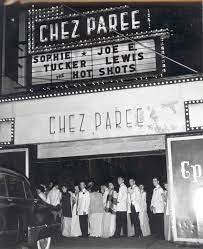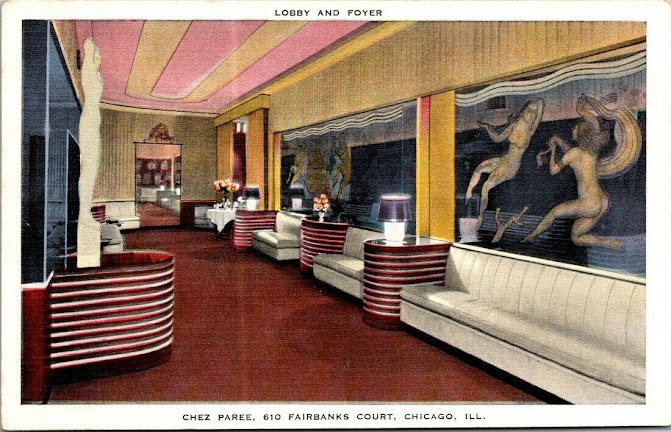The Chez Paree was a Chicago Dinner Theater and a Key Club best known for its stellar cuisine and top entertainment.
 |
| A CLUB KEY |
The Chez Paree opened in 1932 at 610 North Fairbanks Court, in The Streeterville neighborhood of Chicago. The fully air-conditioned club was a thriving example of golden age entertainment. They hosted famous musical groups, comedians, big band talent, famous dance bands, and some vaudeville.[1]
There were casino games played in the Key Club.
Popular entertainers included Jimmy Durante, Martin & Lewis, Sophie Tucker, Tony Martin, Danny Thomas, and Sammy Davis and Sammy Davis Jr. This is where Chicagoans took business people, politicians, and out-of-town family and friends to impress them when showing off our city.
The floor was crowded with tables. There was a large dance floor in front of the stage. The Cocktail Lounge had a circular and glamourous bar.
The Chez Paree closed in 1960.
 |
| A Friday or Saturday night crowd at The Chez Paree. |
 |
| Chez Paree, Liberace in The Key Club. |
 |
| Mae West with Chez Paree co-owner Jay 'Jack' Schatz in the mid-1950s after a night of performances. |
 |
| Louis 'Satchmo' Armstrong in The Key Club at The Chez Paree. |
 |
| Bob Hope, Mike Wallace, and his wife Buffy broadcast a radio show from The Chez Paree. |
 |
| Jimmy Durante with The Chez Paree co-owners Jay 'Jack' Schatz and Donjo Medlevine in The Key Club. |
 |
| Pearl Bailey and husband Louie Bellson (far right) in The Key Club. |
 |
| Lena Horne in The Chez Paree Key Club. |
 |
| Nat King Cole with co-owners Jay 'Jack' Schatz and Donjo Medlevine in The Key Club at The Chez Paree early-1950s. |
 |
| The Will Mastin Trio, comprised of Will Mastin (2nd from left), Sammy Davis Jr (far left), and Sammy Davis Sr. (2nd from right) have some laughs with Chez Paree co-owners Jay "Jack" Schatz and Donjo Medlevine. |
Compiled by Dr. Neil Gale, Ph.D.
[1] Vaudeville is a theatrical genre of variety entertainment born in France at the end of the 19th century. In the United States, the term connotes a light entertainment popular in the states from the mid-1890s until the early 1930s. Vaudeville, more so than any other mass entertainment, grew out of the culture of incorporation that defined American life after the Civil War (1861-1865). The development of vaudeville marked the beginning of popular entertainment as big business, dependent on the organizational efforts of a growing number of white-collar workers and an increase in leisure time, spending power, and changing tastes of an urban middle-class audience. Shows usually consisted of 10 to 15 individual, unrelated acts, featuring magicians, acrobats, comedians, trained animals, jugglers, singers, dancers, and other odd acts.




















My father, Ed “Poggy” Poggensee played the trombone at the Chez for years. As a child he brought my brother, mom and me to see Red Skelton. Dad took me to Mr. Skelton’s dressing room. I remember his big smile and kindness. Dad played for many of the big names and loved it, I have many autographs from the greats. I remember Dad saying he was in the elevator with Sophie Tucker after the show and she said “I can’t wait to take off my girdle.” While the kids on our blocks dads were coming home from work around 6 p.m., our dad was putting on his tux and fancy dress black knee high socks.
ReplyDelete